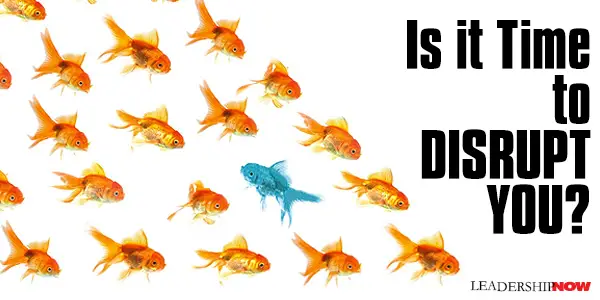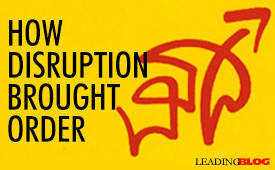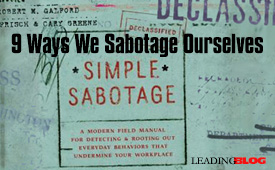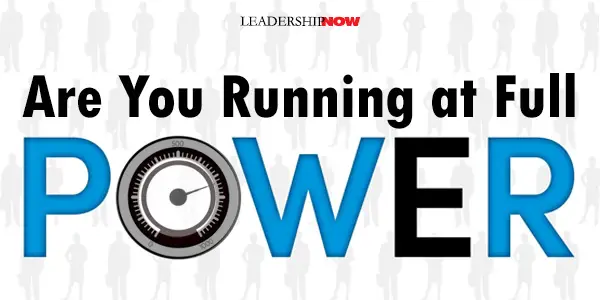 Leading Blog | Posts by Month |
 Leading Blog | Posts by Month |
07.31.15

LeadershipNow 140: July 2015 Compilation
See more on
Posted by Michael McKinney at 11:43 AM
07.24.15

You Can’t Lead If You’re in the Weeds As you confront our day-to-day demands from this place, you are more likely to be: response-driven, multidimensional, flexible, proactive, and engaged. However, when your margin runs low and the inverse equation of shrinking resources and increasing demands stresses our capacity to the breaking point, the strain can tilt you away from the Performance Zone and push you out into the weeds toward the Danger Zone. In this overwhelmed place, it’s easy to get into a reactionary mode where priorities get blurred by the fatigue of doing more with less. The bottom line is that you can’t lead if you’re lost. To know whether your demands are pushing you out of the Performance Zone, consider each of the following questions and answer with either “Yes” or “No” depending on whether the statement is true for you:
When we are stuck in our own dilemmas, we somehow start believing that this is how work has to be. Over time, the cumulative effect of this way of thinking and working leaves us feeling like there is truly no way out. What was easy is now difficult. What was enjoyable is now unsatisfying. What used to give us a sense of purpose now seems unimportant. The good news is that you can get yourself out of the weeds and back on track – even when you cannot change the responsibilities you face. It turns out that the dilemma’s triggers are swinging doors and within each one there is an alternative path that acts as an escape hatch. To exit the dilemma, you have to go out the way you came in:
Jesse Sostrin is the author of The Manager’s Dilemma. He writes and speaks at the intersection of individual and organizational success. Follow him @jessesostrin. 
Posted by Michael McKinney at 01:57 AM
07.20.15

Is it Time to Disrupt You?
“I was presenting myself to the world as an out-of-shape, intimidated middle-aged man. That needed to change,” writes Jay Samit. Disruption can be a powerful and positive force. If we are to work with and take advantage of the disruptions in the world around us, we must be willing to disrupt ourselves. All disruption, says Samit in Disrupt You!, begins with introspection. After an early failure, he began a process of self-disruption. “I analyzed all the pieces that came together to form my identity. I began to define what unique experiences and knowledge I had that would set me apart from my peers. I thought about the way I made decisions, how I processed and responded to information, how I approached problems. I thought about the way I presented myself to the world and how I communicated my abilities to potential business partners and clients. And I thought about how I was sending my time and energy. If I was going to find opportunities to make a name for myself in the world, I was going to have to change something in my approach.” This a lot to tackle, but it is a process we all need to face. It can be very difficult to confront our assumptions about ourselves and the world around us to create a reimagined self. It is difficult to upend what we have built—our identity and approach—in exchange for a better future. It’s unknown. We are often more comfortable with what we have always done—even if it is not working for us—than we are moving into unchartered territory. Like any business we also have a value chain—our identities. Any or all of these links may need to be disrupted. You might think of research and development like the way we interpret the world. Where do I thrive? What kind of people do I work with best? What do I believe about myself that might not be true? Production and design are the ways in which you respond to problems. Do I tackle problems with an open mind, thinking holistically? Your reactions to disruptions in your environment will depend on your mindset. The next link relates to how you market and sell your potential. Not what you have done, but what you can do. Success says Samit, is about defining your future. About his own marketing and sales links he writes: We market and sell ourselves in the ways we present ourselves to the world, which are based on what we see as our personal strengths or limitations. We distribute ourselves in the ways we choose to spend our time and where we focus our energies. When viewed from this framework, the process of self-transformation becomes approachable: you need only analyze each link in your internal value chain and find the single link that’s holding you back. Then make changes to that link to disrupt yourself.Finally, distribution is how we spend your time and where we direct our focus. Do I devote my time and energy to achieving my dreams, or am I surfing the Internet every evening? Our time and energy is a valuable resource, we must distribute it wisely. Self-disruption is about making deliberate choices rather than running on autopilot. It’s about making preemptive moves rather than just being a pawn in a game. Samit provides Disruptor’s Map in each of these areas to help you begin disrupting yourself before you are disrupted. Consider where you are and where you want to be. And don’t forget to ask yourself what you want to do along the way personally and professionally. Both are critical areas to consider. Self-disruption can prepare us for the future and the disruptions it will bring. Every disruption brings about opportunities. By analyzing the value chain you can find new ways to capture value. “The real challenge,” says Samit, “is for each of us to determine where we feel we can make the most impact.”   
Posted by Michael McKinney at 06:17 AM
07.14.15

Why You’re Not Achieving Your Goals
BERNARD ROTH, one of the founders of the multi-disciplinary d.school at Stanford University, has written a book titled, The Achievement Habit. However, it is much more than the title might let on. It’s about how you can achieve your goals more fully and faster by expanding your limited view of reality. It’s about design thinking applied to every aspect of your life. It’s about assisting us to break through the walls that are mostly of our own making. You Give Everything Its Meaning Roth begins by reminding us that nothing has any meaning except for the meaning that we give it. “Stop labeling things in their usual way. Make the familiar into the unfamiliar, and the result can be amazing and delightful, as opposed to dull, nonfunctional, and ordinary.” Along these same lines, this applies to our need to be right. “Next time you find yourself playing right and wrong, remember: You give everything in your life its meaning, so you can choose to end the game. It does not matter how right you are or how wrong they are; you lose just by playing.” You have the power to change your attitude and therefore, how you will play the game. Reasons Are Excuses And then there are all the reasons we have for why something is or isn’t happening. They’re really just excuses prettied up says Roth. He was chronically late until he decided to stop coming up with reasons and deal with the real issue. Here’s the key point: We use reasons “to hide shortcomings from ourselves. When we stop using reasons to justify ourselves, we increase our chances of changing behavior, gaining a realistic self-image, and living a more satisfying and productive life.” In other words, we take responsibility for our life. We often get stuck because we are working on the wrong issue. We have some faulty assumptions. “Experience has shown me that one of the main causes of losing sleep over a problem is that we think we are dealing with a question when in fact we are dealing with an answer (a solution) that turns out not to be a good fit to our actual problem.” Letting go of the problem is often the best solution. Roth shows you how to rework your question to find the actual issue. At the d.school there is a bias toward action. Failure is part of the expected result. In reaching our goals we also need to watch our language because it influences the way we see things (and the way others see us too). The word but creates conflict. Using the word and opens up the conversation. Change “I have to” to “I want to.” It clarifies the fact that we have a choice in the matter. Don’t Interrupt Here’s a ego taxing communication tip: Don’t interrupt. “Many people interrupt because they have something that they are afraid they might forget or that it will not be relevant later. The best thing to do is to let it go. If it is still appropriate at the end, say it then. If it gets lost and remains unspoken—no matter how brilliant it would have been—the world will not notice.” Flat Organization Roth describes the flat organization of the d.school over the last forty years. Why and how it works. With a common goal and purpose, I think what Roth describes is possible: “We operated by consensus and negotiation, almost never voting on anything. There was almost no acrimony, and people treated each other with respect, collegiality, and a spirit of shared purpose and commitment.” “We were all in charge, and we wanted to make it work.” If you can overcome your biases, “you might find a management structure that strongly supports what you want to accomplish.” Many more topics from designing workspaces to self-image are discussed. All of it valuable. Each concept is followed by a “Your Turn” section to give you tools and techniques to apply these ideas to your own situation. When you hold yourself in high esteem and keep a positive outlook on your future, others will usually follow suit. By choosing the meaning we give to people and things in our environment, ultimately we control our own experiences, no matter what work we are doing.

Posted by Michael McKinney at 09:44 PM
07.10.15

Are You Running at Full Power?
ONLY about 10% of us are running at full power! Power Score is designed to help you determine why you might not be performing at your best.Your Power Score (P x W x R) is based on three questions you should be asking yourself and your team: Do we have the right priorities?
“The key to great leadership is to have the right priorities, the right people on your team, and the right relationships that achieve results.” Interestingly, their research found that where most leaders were weakest related to the who and then priorities. The relationship factor was the strongest factor by far. To score high on the Priorities factor, the priorities connect with the mission (the why), they are the right ones (will they get you what you want), and they are clear (focused).
To score high on the Relationships factor means building relationship that function well together and achieve results. Is communication coordinated within and beyond the team? (Communicating with the right people at the right times.) Is our team committed to the mission and to one another? (Emotionally invested in their work.) Does our team feel challenged to accomplish something bigger than themselves? (Feedback and mutual accountability. A challenged team will remain a committed one.) The book provides a questionnaire to help you and your team determine your own power score. You will also find instructions to have a follow-up power conversation. By having a power conversation with your team and rating each of these areas you can discover areas where you can improve and increase your power score.  Of Related Interest: 
Posted by Michael McKinney at 08:49 AM
07.08.15

The Benefits of Putting Yourself Where the Action IsThe Front-Line Leader by Chris Van Gorder is about leading with not over employees. To be effective as a leader you have to connect with people. You must get to know them—really know them.Van Gorder has carried with him lessons he learned as a security guard and a police officer to lead Scripps Health from near bankruptcy to a dominate market position. He explains several behaviors that will help to connect with people and lead from among them. For instance he recommends that you:
Here are a couple of other thoughts from Van Gorder: When I find myself becoming a little too smug as a CEO, I alert myself to all the ways that I’m still learning. This leaves me feeling that much closer to that young nurse and that information technologist who are also feeling their way ahead. 
Posted by Michael McKinney at 08:40 AM
07.06.15

Could Embracing Ignorance Improve Your Leadership?Orchestral conductor Itay Talgam writes in The Ignorant Maestro, that “the greatest leaders not only embrace ignorance but are convinced it is an essential choice on their part, allowing their people to reach upper floors that haven’t even been built yet.”In short, your willingness to let go of knowing—the conscious decision to be ignorant, to not know the answers, not even try to predict them—and embrace the unknown will be the crucial tipping point in making you the best leader you can be. The ignorance that Talgam speaks of is not about having a lake of knowledge, but being open to exploring other knowledge. It is humility. It is built on our knowledge but it is the willingness to go beyond what we know—to explore the unknown—so that the future is a matter of choice rather than the result of inertial thinking. Ignorance combined with two other qualities, the willingness to explore the gaps and listening, can create the space for others to fully express themselves. Gaps arise from incompatibilities; when something doesn’t make sense; the difference between what we say and do. They invite exploration and creative work. “Gaps with the most potential are often the most intimidating ones, so they are probably covered with layers of tradition, routine, and ‘that’s the way we’ve always done it here’ attitude.” “When we avoid gaps,” say Talgam, “we give up the possibility of choosing an interpretation for them, of putting them into context, of giving them a story. Our openness to new meanings is what allows the freedom to choose a different future. This invites the constructive participation of all stakeholders and that requires a high degree of listening. Great leaders listen from the perspective of ignorance. Instead of focusing on transmitting knowledge, focus on creating dialogue. Create the space for dialogue and learning by listening. “As a leader your choice for ignorance makes you focus on the learning processes of your people, supporting them in their autonomous discoveries.” Listening focuses on holding the space open for that exchange rather than on the outcome. “Gaps are the renewable fuel of new thinking, enabling change. Gaps exploration, around your organization’s leading values and ideas, is a great sustainable energy source.” You explore gaps by “choosing to be ignorant, and by listening from the unique perspective of ignorance.” Talgam looks at the leadership styles of six great conductors in terms of how each of them did or do embrace ignorance, explored gaps and listened. In terms of leaders creating a connection with those they lead, the example of Leonard Bernstein is instructive. For Bernstein it was not a nicety but a necessity. For a precious half hour or so he was not rehearsing at all but moving around among people, greeting each and every player by name, his arm around a shoulder, hugging some and kissing others. Engaged in a hundred conversations, he was catching up with domestic news, remembering names of children and events he had been told about maybe a year earlier. These were not just niceties but the manifestation of relations based on empathy and mutual trust. These precious thirty minute were the basis for making music together. 
Posted by Michael McKinney at 08:23 AM
07.03.15

5 Reasons You Need to Make a Connection Culture Your Highest PriorityA culture that connects people would seem to be a high priority to leaders. Building a sense of community would seem to be a necessary first step before a leader does anything else. But a connection culture is not a common as you might expect.Perhaps this largely because our human nature still leads us to believe that we can always default to command and control when we have to. Or perhaps we just get so busy that we have no time for relationships. We just need to get the work done. Michael Lee Stallard makes the case in Connection Culture that in order to achieve sustainable, superior performance, every member of an organization needs to intentionally develop both task excellence and relational excellence. That is they need to be continually learning and developing healthy relationships with others. Stallard notes that “most organizations contain a mixture of connection cultures, cultures of control, and cultures of indifference, indicating that most leaders are not intentional about developing connection and connection cultures. Creating connection cultures should be an organization’s highest priority because:
Vision: When everyone in the organization is motivated by the mission, united by the values, and proud of the reputation. Value: When everyone in the organization understands the needs of people, appreciates their positive unique contributions, and helps them achieve their potential. Voice: When everyone in the organization seeks the ideas of others, shares their ideas and opinions honestly, and safeguards relational connections. Connection is a character issue. It’s about your attitude, language and behavior. Start on your local culture where you have an influence either formal or informal. Stallard advises that we also “consider how it applies to your family, your neighborhood, the community organizations you are involved in, and other areas of your life, and then take action to increase connection in those spheres as well.” If you are looking to take your leadership to the next level, connect with others at every level. 
Posted by Michael McKinney at 08:08 AM
07.01.15

First Look: Leadership Books for July 2015Here's a look at some of the best leadership books to be released in July.




For bulk orders call 1-800-423-8273  Build your leadership library with these specials on over 100 titles. All titles are at least 40% off the list price and are available only in limited quantities. “Wear the old coat and buy the new book.” — Austin Phelps
Posted by Michael McKinney at 09:16 AM
|
BUILD YOUR KNOWLEDGE


How to Do Your Start-Up Right STRAIGHT TALK FOR START-UPS 
Grow Your Leadership Skills NEW AND UPCOMING LEADERSHIP BOOKS 
Leadership Minute BITE-SIZE CONCEPTS YOU CAN CHEW ON 
Classic Leadership Books BOOKS TO READ BEFORE YOU LEAD |
|